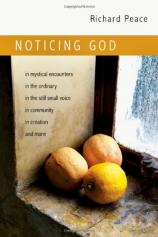Noticing God
Review
Noticing God
Sometimes a good nonfiction book provides fresh inspiration. Period. What do I mean? There may be nothing new in terms of information. It’s well-aged content. But the book speaks because of the author’s manner and voice and fresh presentation. I’m of course referring to NOTICING GOD.
Author Richard Peace is a well-published professor of spiritual formation and evangelism. Though he hardly mentions these aspects of his experience, he’s also been a filmmaker and a missionary in South Africa. In these pages, he’s guiding his readers along a spiritual path he himself has journeyed, learning to notice the God who is here.
"Sometimes a good nonfiction book provides fresh inspiration.... There may be nothing new in terms of information. It’s well-aged content. But the book speaks because of the author’s manner and voice and fresh presentation. I’m of course referring to NOTICING GOD."
Like many Protestants, Peace was originally unfamiliar with spiritual modes promoted by saints of old and largely ignored by 20th-century American evangelicals. For example, he spends a chapter (“God in the Ordinary”) and a good portion of the book’s conclusion, “How Do We Know It Is God?” laying out principles of Ignatian-Jesuit spirituality. Another chapter, “The Written Word,” gives the steps of reflective, prayerful Bible reading, often known as lectio divina. And a chapter on community focuses largely on aspects of the Benedictine rule, including hospitality. One of the best portions of the book is a discussion here of “spiritual fruit” and “spiritual gifts.” His text comprises solid teaching with engaging anecdotes.
In seven chapters, Peace delves into seven ways of finding/hearing/noticing God. He starts right off with a chapter on “mystical encounters.” Yes, they’ve influenced the course of history (including the conversion of the apostle Paul) and shouldn’t be discounted out of hand, but Peace notes that they “are not the purpose of life” nor can we “‘order up’ a mystical experience, it is not healthy to become preoccupied with having [or running after] such an encounter.”
God is more likely to speak with “the still small voice” (chapter three), what Peace has experienced as “the gentleness, the lack of insistence, the brevity, the sense of rightness” of an inner voice. For him, “This was unlike inner hints, hunches or what happens in the creative process.” Peace mentions the positive effect of setting aside time for silent retreats as well as the potential power of dreams, among other aspects or venues of hearing God’s personal word to us.
A sixth chapter discusses finding glimpses of God --- “intimations of transcendence” --- in creation, in “culture” including film, and in the midst of or as a response to the creative process. How do we encounter God through these venues? By “the way of analogy”; “the way of affect”; “the way of the intellect”; and “the way of the artist.”
Chapter seven gets to the heart of finding God at church, in corporate worship, through Sacraments and song, teaching, fellowship and serving.
A final “Conclusion” (why isn’t this a “real” chapter eight?), about discerning how to “know it is God,” is excellent and critical to the book as a whole. Questions for reflection or discussion (for eight sessions) are tucked in at the end of the book, as is a good “further reading” section.
Reviewed by Evelyn Bence on June 21, 2012
Noticing God
- Publication Date: April 13, 2012
- Genres: Christian, Christian Living, Nonfiction, Theology
- Paperback: 189 pages
- Publisher: IVP Books
- ISBN-10: 083083821X
- ISBN-13: 9780830838219




